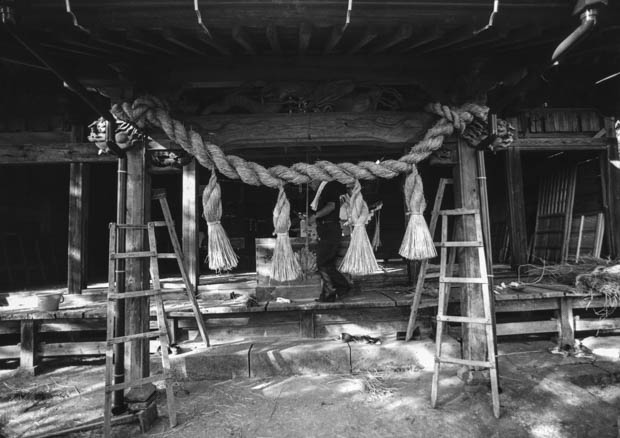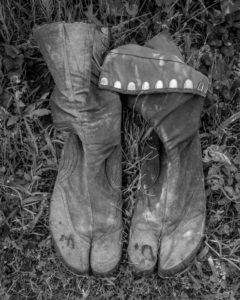
on the road’s edge 道の端
five snake gourds からすうり五個
protect the mountain 山護る
(michi no haji, karasu uri go-ko, yama mamoru)
I knew all about the magic of using rice straw. It is one of the main methods of Fukuoka-san’s Natural Farming (see One Straw Revolution, by Masanobu Fukuoka). In the mountains of Kyōto, his gaijin disciple had shown me the proper way to shake the rice straw onto the field, how to make it look as if the stocks had been laid there by nature or the hands of some unseen earth goddess. The movement is similar to a cheerleader waving pom-poms.
On Fukuoka-san’s natural farm, I had helped his live-in students scatter the seeds of winter wheat in an unplowed field. We must have a looked like dancing scarecrows as we imitated nature by covering the seeds with rice straw from the fall harvest. The idea is simple, but making it appear natural takes practice. After a rain or two, it’s easy to find the seeds sprouting between the cracks in the straw. Daikon radish and other hearty vegetables are easy to grow this way.
Those tough weeds and wildflowers we see in the cracks of city sidewalks and cement walls follow the same principle. Earth, rain, sun, and wind come together naturally allowing their lives to happen. If man or a bird lends a helping hand the process works better, but we are not really necessary.
⁂

At 8:00 a.m. on the morning of a national holiday, we assembled on the steps in front of the shrine. People were dressed in garb that ranged from traditional happi coats and jikatabi shoes to jogging suits, blue jeans, and brand-name sneakers. Our task was to clean up the local shrine and its precincts for the annual fall harvest festival to be held in a week, and most importantly, to weave a new shimenawa straw rope for the shrine and its torii gate.
The workers were mostly male, ranging in age from 30 to 80. It seemed our purpose was not only to clean the shrine and make the shimenawa with the newly harvested rice straw, but also to experience the communal aspect of the neighborhood, take pride in our local area, and perhaps in ourselves, too. It was a ritualistic upholding of a clan tradition, preserving the rice culture in a primitive and basic sense. These seemed like lofty goals, so I was willing and ready to work.
I soon realized that the weaving of the cord symbolically interweaves the lives of the community together in a harmonious pattern, strengthening old friendships and, in my case, creating new ones. Could I become one of the unique straws woven into the rope of this microcosm of Japanese society? Better than being the odd nail that needs to be hammered down into some conforming space.
Theoretically I was a local, but I worried about a gaijin (foreign) presence at a custom connected to a native religion. I didn’t want to upset the traditional Japanese mood of the group. A few who knew me helped to ease me into the circle. My tree trimming and sweeping skills (learned as a gardener in Tokyo) plus my own worn jikatabi, helped me blend in.
Everyone worked together, teasing and joking with each other, chatting about their lives. It was an opportunity for Japanese-style socializing. At times, however, an occasional expression on someone’s face suggested something different. My guess was people might not be there of their own free will, but their presence was obligatory. They might prefer to have been elsewhere socializing with people of their own choice, but afraid of losing face by not attending.
A young man who arrived late from his amateur baseball team practice still wearing his uniform got a dirty look.
“Mata yakyu desu ka?” (“Baseball again?”) was a subtle criticism from one of the elders.
I too had been sucked into it. Shimizu ojii-san, a grandpa I liked and who had helped me learn the village ways, had invited me, so I felt I had to go. Anyway, I thought it would be a good learning experience. I had been in Japan long enough that societal obligation had somehow gained control of me at a basic, local level. Whether the others thought they were being controlled and whether they thought it was right or wrong is not something they would ever talk about. Or if they did, they’d likely give the standard reply I didn’t care for: “Shōganai” (It can’t be helped). When I heard that, I wanted to shout, “Shōga aru!” (There might be another way, literally “There is ginger!”)

For many, being rewarded at the end of the day for hard work with plenty of sake and a sashimi seemed to make it all worthwhile. “This is the best work time we’ve ever had,” several men agreed, as slices of raw fish slid down their throats and they fought for the chance to fill my cup with sake.
After the go kuro sama (Cheers for the hard work!) party, one man in his joyful intoxication invited me to his place for a cup of strong green tea. Grassroots internationalization and socializing: tsukiai with a broom and a cup. By helping to weave the sacred rope, part of my life had become entwined with the community. Our level of relating and greeting each other at the store and on the local roads changed in a pleasant and subtle way. I was now at least partially on the inside. In Japanese society, especially in the countryside, this was a big step.
These days most farmers are not much interested in the possibilities of rice straw, traditional or natural. They might save the best straw for making shimenawa, the sacred shrine rope and New Year’s decorations, but after that they are happy to let me take what I want to use in my garden. The straw makes great mulch and adds bulk to the compost pile. Using it is one of my ways of honoring the gods by giving something back to the earth.
This is an excerpt from “Whisper of the Land: Visions of Japan” by Edward Levinson (Fine Line Press, 2014). Text and photos copyright Edward Levinson.
About the Author:
Edward Levinson is an American photographer specializing in pinhole photography, who has lived in Japan since 1979. He is also an essayist and poet. Timescapes Japan, his award winning photo book, was published in 2006. In addition to Whisper of the Land he has published two essay books in Japanese (Iwanami Shoten). Edward’s photographs are exhibited regularly in Japan and abroad. He lives on Chiba’s Boso Peninsula inspired by nature and his garden. Edward’s photography site is Edo Photos. For book information and orders see his book website Whisper of the Land. (Mention “Books on Asia” for a 200 yen discount).
